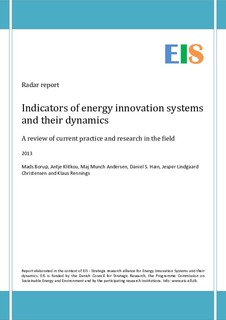| dc.description.abstract | The purpose of this ‘radar report’ is to give an overview of the state of the art concerning indicators of energy innovation systems and their dynamics. As part of this, it is the aim to discuss current challenges and efforts made by researchers and other professionals working in the field. Through this, the radar report shall contribute to the discussion of how the field might develop in the future; both for the sake of understanding the dynamics of energy innovation systems in general and, more specifically, for the sake of understanding the role energy innovation systems play for moving towards more climate-friendly and sustainable energy systems.
The analysis behind the radar report builds on a search and review of research literature, databases, statistics schemes, etc., on indicators of energy innovation systems as such and on relevant connected issues. In addition, it builds on assessment and insights from experienced researchers in the field. It is the intention with the report to communicate knowledge from researchers to other interested parties; not only to other researchers, but also to stakeholders more broadly, e.g. interest organisations, policy makers, statisticians, etc. However, a one-way communication picture is not entirely correct. Not only do researchers in many cases build on nationally or internationally recognized indicator schemes and databases established by governmental bodies, statistics agencies or international organizations like the OECD (Organisation of Economic Cooperation and Development) and the IEA (International Energy Agency). Researchers are also in a number of cases involved in establishment and development of official indicator schemes for example by acting as advisors or carrying out background studies. The interaction between research and practitioners is complex, and it makes little sense to address scientific research activities only, without taking into consideration the broader picture of indicator schemes. What we researchers most obviously can contribute with compared to other professional bodies in the field, is an explicit theoretical analysis perspective, in this case based on innovation system theory. Through this we can hopefully point out issues and raise questions that would otherwise not have been addressed. | nb_NO |
